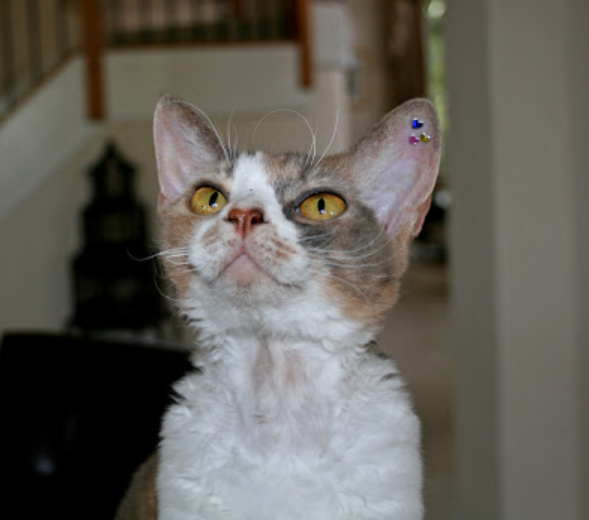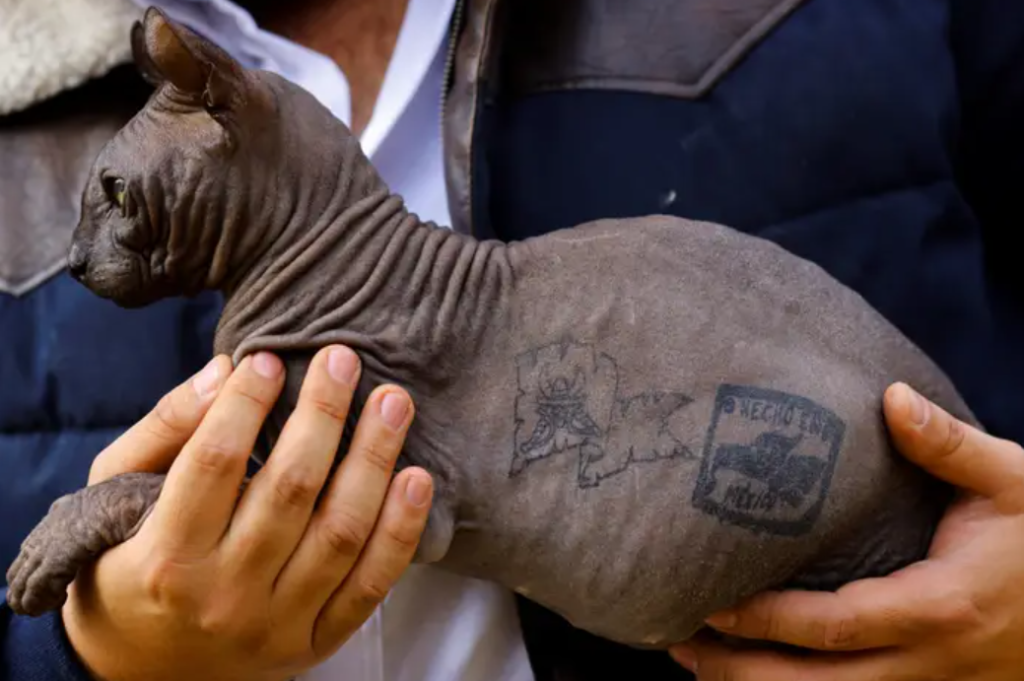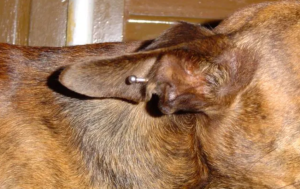Getting your cat’s ears pierced may seem fun and trendy, but it’s a controversial topic. Unlike dogs, ear piercing is not common for cats. Should you pierce your cat’s ears? While some owners swear by it, many vets and animal welfare groups strongly advise against feline ear piercings. This beginner’s guide covers everything you need to know before deciding if ear piercing is right for your cat.
Ear piercing for cats has grown in popularity in recent years thanks to social media. Some owners think pierced ears can be cute or even help identify an indoor cat if lost. However, ear piercing also carries risks like infection, pain, and permanent damage. Most veterinarians and animal experts caution strongly against piercing a cat’s sensitive ears.
So should you pierce your cat’s ears? This comprehensive guide lays out the key facts, pros and cons, risks, costs, aftercare, alternatives, laws, and expert opinions to help you make an informed decision. We’ll also overview the ear piercing process itself step-by-step. While the choice is ultimately yours as a pet owner, this article aims to provide unbiased information from credible vets and sources so you can weigh the options.
The Risks and Cons of Feline Ear Piercing
Ear piercing does come with some downsides and hazards—which is why many experts advise against it for cats. Here are some of the main risks and cons to be aware of:
Infection
A major risk is infection at the piercing site. Cat ears contain very thin skin and cartilage which could easily become infected. Signs of infection include redness, swelling, heat, and pus/discharge at the piercing. Left untreated, the infection can spread and cause permanent damage.
Pain and Discomfort
A cat’s ears are very sensitive. The piercing process and healing can cause throbbing, irritation, itching, and general discomfort. Cats may shake their heads, scratch at their ears, and act agitated from the pain.
Permanent Damage
If an infection develops or the piercing is ripped out, it can leave scars, misshapen ears, or holes/tears in the cartilage. The ears may also develop hematomas (fluid build-up) and abscesses. This damage is irreversible.
Allergic Reaction
Some cats may be allergic to the metal in the earring, leading to reactions like swelling, oozing, and crusting around the site. This can quickly become serious if not treated promptly.
Swallowing or Choking Hazards
There is a risk a cat may swallow a dislodged earring back or choke on the post itself. Cats like batting around and chewing small objects. If any part of the earring comes off, this poses an internal health hazard requiring immediate veterinary care.
Catching or Snagging
Pierced ears have the risk of catching on objects like fences or brush. They can easily snag and rip leading to pain and tears. This is dangerous as cats love exploring the outdoors.
Veterinary and Anesthesia Risks
Most vets won’t perform ear piercings, so you may need to go to a dubious piercing shop. The piercing also requires fully sedating the cat which always poses anesthesia risks like breathing issues or heart problems.
Legality Issues
Ear piercing is illegal in some regions and certainly constitutes animal cruelty if not done properly under anesthesia with veterinary supervision. Owners can face fines and custody issues for ear piercing without due care.
Ongoing Upkeep
The piercings require frequent cleaning, disinfecting, and turning of the earrings during the 6-8 week healing time. Cats won’t understand this care is meant to help them. It can be challenging handling their sore ears.
Cost Factor
Professional piercing with a vet will cost at least $60-$100 or more. There are also risks of lawsuits and fines if problems arise. Compared to free alternatives like an ID tag, the price may not justify piercing ears.
The Pros and Cons of Cat Ear Piercing:

Pros:
- Decoration: Earrings and studs can provide decorative flair to your cat’s look. Some owners enjoy accessorizing their cats.
- Identification: Earrings with contact info could help identify an indoor cat if lost. However, a collar or microchip works better.
- Trendy: Pierced cat ears are trendy on social media and in some celebrity/fashion circles. It can be a status symbol of sorts.
- Bonding: The act of piercing may help some owners bond with their cat during the process.
Cons:
- Pain: High risk of pain, irritation, discomfort during piercing and healing. Very sensitive ears.
- Infection: Ears are prone to infection, swelling, discharge. Can spread and cause lasting damage.
- Permanent injury: Tears, hematomas, misshapen ears, ripped cartilage are possible if problems arise. Irreversible.
- Choking hazards: Cat could swallow dislodged earring or choke on posts. Requires emergency vet care.
- Legal issues: Considered animal cruelty in some regions. Owners can face fines and charges.
- Costs: Professional piercing is expensive at $60+ not counting complications. Ongoing cleaning is demanding.
- Vet reluctance: Most vets refuse to pierce ears given risks. May need to go to untrained piercing shop instead.
- Alternatives exist: Collars, microchips, and ID tags work better for identification. Ear tattoos also possible but not recommended.
What Do Veterinarians Say About Cat Ear Piercing?
Most veterinarians strongly discourage cat ear piercings and will refuse to perform them. Here are some opinions from vets:
- Dr. Danielle Bernal, a veterinarian for over 10 years, states: “I advise against ear piercing for cats. A cat’s ears contain little cartilage and muscle. This makes them prone to tears and infection which can be a lifelong issue. I’ve treated many complications from owners piercing their cat’s ears themselves with a needle and hoop earring. Even if done by a vet, the risks outweigh any benefits in my professional opinion.”
- According to veterinary doctor Linda Simon: “A cat’s ears serve important functions like sound detection and balance. Piercing them incorrectly could affect these senses long-term. Overall, I cannot ethically recommend piercing given the risks of infection, abscesses, Hendrama, choking hazards, and sedation side effects.”
- The American Veterinary Medical Association officially discourages ear piercing as an unnecessary cosmetic procedure that provides no medical benefits. Most vets refuse to pierce ears even if asked by clients.
- Dr. Jessica Vogelsang, DVM, writes: “I don’t recommend piercing your cat’s ears. She will have to be sedated for the procedure, and her ears have very little flesh or cartilage to support a piercing. Even if you are diligent in caring for the piercing site, sometimes cats can catch earrings on things and tear their ears.”
So in summary, most veterinary professionals strongly advise against cat ear piercings given the multitude of risks and lack of medical necessity. Some may consider it only under strict anesthesia, aftercare, and owner compliance protocols. But the prevailing view is ear piercing cats is inadvisable.
What Do Animal Welfare Groups Say?
Major animal welfare organizations like the ASPCA and Humane Society also strongly discourage ear piercing for cats:
- The ASPCA is against ear and nose piercing for cats, saying “Not only is it unnecessary, but it can subject cats to pain and serious health issues.”
- PETA President Ingrid Newkirk: “PETA very much disapproves of piercing kittens’ ears or nose cartilage. Cats are not fashion accessories for someone to torture in order to make a dubious fashion statement.”
- The Humane Society opposes ear piercing or any piercing of cats, deeming it an “unnecessary cosmetic alteration with no benefit to the cat.”
- Forever Meows: “We believe cat ear piercings are inhumane as they cause unnecessary pain and stress to cats. Permanent damage or scarring is also possible. We thus discourage ear piercing for cats.”
So major animal welfare organizations stand united against piercing cats ears as an unethical and hazardous practice. Some even classify it as animal abuse. At a minimum, piercing advocates must follow strict precautions, aftercare, and use humane methods.
What Methods Can Minimize the Risks?
While not recommended generally, some vets may be willing to perform ear piercings under proper medical conditions to minimize risks, including:
- Full anesthesia – The cat must be fully sedated by a vet to avoid pain, squirming, and stress. Never pierce at home without anesthesia.
- Proper tools – Use a sterile, medical-grade piercing instrument and new hypoallergenic studs or hoops. Clean tools prevent infection. No sewing needles or unsafe jewelry.
- Veterinary oversight – Have the procedure done start-to-finish by a licensed vet familiar with ear anatomy. They can best place the piercing correctly.
- Pain management – Vets can prescribe cat-safe pain relievers to make recovery more comfortable.
- Antibiotics – Administering oral antibiotics for 1-2 weeks prevents infection and reduces swelling.
- Elizabethan collar – A cone prevents the cat from scratching and interfering with the piercing. Stop them pulling out the earring.
- Proper aftercare – Careful daily cleaning of the area using saline spray or wipes. Regularly check for problems.
- Short earrings – Initial studs should have very short posts to reduce risks and snagging. Upgrade to longer posts once healed.
Following anesthesia protocols and these precautions under licensed veterinary care can help reduce risks if you ultimately decide to pierce ears. But problems are still possible even in ideal scenarios.
What Are the Laws on Cat Ear Piercing?
The legality of ear piercing varies, but here are some key laws owners should know:
- The UK and EU prohibit cosmetic ear piercing of cats as animal cruelty. Violators face fines of up to £20,000 in the UK.
- New York, New Jersey, and Massachusetts have banned piercing cats’ ears with penalties of up to $1000 and jail time for offenders.
- Other US states like California, Illinois, and Texas allow piercing but only under anesthesia by licensed vets, not piercing shops. Owners can still be charged with abuse without proper precautions.
- The American Veterinary Medical Association considers ear or nose piercing of cats “unethical unless done for medical benefit under anesthesia.” Most US vets refuse to pierce ears regardless.
- No states allow piercing a cat’s ears at home. Anesthesia and vet supervision are legally required everywhere.
So while certain areas prohibit feline ear piercings entirely, it is allowable under anesthesia in other regions. But owners can still face animal cruelty charges if not done humanely following veterinary standards of care. The laws aim to maximize safety and minimize risks.
What Are the Costs of Professional Cat Ear Piercings?
Here are typical costs if done legally under veterinary supervision:
- The piercing procedure itself generally runs $60 – $100 at vets willing to do it. More for specialized piercing clinics.
- Anesthesia also adds $50 – $150 to the cost since full sedation is required.
- Initial earrings suitable and safe for cats will cost $20+. Go for hypoallergenic metals.
- Antibiotics and anti-inflammatories for aftercare average $30 – $60.
- Follow-up vet visits to monitor healing approx. $50 per visit.
- Additional costs if complications like infections develop requiring urgent treatment.
In total, expect to invest $200 – $400+ for the initial piercing, medicine, anesthesia, follow-ups. Annual checkups and earring replacement will also incur ongoing costs. Compared to a simple collar, ear piercing is a significant investment.
What Are the Pros and Cons of Tattooing vs. Piercing Cat Ears?

Some owners get their cat’s ears tattooed instead of pierced. Here are pros and cons of each method:
Tattoo Pros
- Permanent identification
- Lower infection risk
- Won’t snag or get pulled out
- One-time cost
Tattoo Cons
- Still requires anesthesia
- Permanent cosmetic change
- Potential ink reactions
- Extra handling and stress
Piercing Pros
- Can remove jewelry anytime
- Cute accessories to mix up
- Trendy and social media friendly
Piercing Cons
- Higher infection chances
- Discomfort during healing
- Risk of catching and tearing
- Ongoing costs for new earrings
Overall, ear tattoos carry fewer health risks but are permanent. Piercings allow changing out jewelry but have higher complication rates and safety issues. Most vets discourage any cosmetic modification like tattooing or piercing cat ears.
8 Key Tips for Safe Ear Piercing Aftercare
If you do opt to pierce, proper aftercare is crucial. Here are some top tips for safe healing:
✔️ Clean piercings twice daily using saline spray or wipes. Gently wipe away crusts.
✔️ Check for redness, swelling, discharge indicating infection. See a vet promptly if you spot signs.
✔️ Rotate the earrings each day after the first week to prevent sticking.
✔️ Avoid letting your cat scratch or pull at the area. Use an Elizabethan collar if needed.
✔️ Disinfect jewelry before insertion. Wash hands before touching pierced ears.
✔️ Choose lightweight earrings with hypoallergenic metals. No heavy danglies.
✔️ Keep monitoring healed piercings for issues. Schedule annual checkups with your vet.
✔️ Remove earrings if problems develop and let piercings close up. Re-piercing later poses more risks.
Diligent aftercare and checking for complications are vital for your cat’s safety and comfort. Be vigilant and don’t ignore any abnormal symptoms.
What Are Safer Alternatives to Ear Piercing for Cat Identification?
Far safer options exist to ID cats that don’t pose health hazards:
Microchipping
A tiny implant injected under the skin stores your contact info. Vets and shelters can scan it if your cat is lost. Painless, permanent, and low cost.
Collars
Breakaway cat collars let you attach ID tags with your phone number and pet’s name. Easy to spot. Replace tags if info changes.
ID Tattoos
Tattooing the INSIDE of the ear with your phone number is an option. Less risky than decorating the outer ear.
GPS Trackers
Slip a GPS tracker onto a collar to monitor your cat’s location from your phone. Help find an escaped pet.
Photos
Take clear, close-up photos of your cat from multiple angles. Useful for making lost pet flyers. Include unique markings.
With safer alternatives available, subjecting cats to the risks of ear piercing is difficult to justify. Prioritize your pet’s health and safety above trendy appearance.
Frequently Asked Questions
Is it painful to get my cat’s ears pierced?
Yes, ear piercing is quite painful for cats without anesthesia. Their ears contain sensitive nerves and thin tissue. The piercing sensation itself is stressful and uncomfortable. Even with pain medicine, cats often act bothered during the healing period. Infection and tearing can worsen discomfort.
How long does a cat ear piercing take to heal?
With proper aftercare, pierced cat ears take 6-8 weeks to fully heal. The piercing will seal up in under a month but remains fragile. Vets advise keeping earrings in and continuing care for 2 months to prevent re-tearing the fresh piercing.
Can a regular piercing shop pierce my cat’s ears?
No, regular piercing shops should never attempt to pierce cats. Only veterinarians have the necessary expertise, anesthesia, and tools to correctly pierce ears on live cats humanely. Home piercing is also illegal and hazardous.
What gauge needle should be used to pierce cat ears?
Vets usually recommend gauge 20 or 22 needles to pierce cats ears. The narrow diameter helps minimize trauma to the sensitive tissue. Choose hypoallergenic stainless steel or surgical titanium needles and starter studs. Never use makeshift needles or jewelry meant for humans.
Do I need my vet’s permission for a cat ear piercing?
No, but your vet can refuse to do the piercing or provide anesthesia. Check first before sourcing another vet for piercing services. Reputable vets will first have you sign consent forms outlining the risks before agreeing to perform ear piercings on cats.
Conclusion
While ear piercing cats has increased in popularity recently, it remains a highly controversial and widely discouraged practice among vets, welfare groups, and laws. Significant health and safety risks exist, from infection and trauma to choking hazards and legal penalties for owners. Proper veterinary procedures under anesthesia can reduce risks, but complications are still possible requiring intensive aftercare. With microchipping and collars offering safer ID options, subjecting cats to unnecessary piercing is hard to justify ethically. The choice is ultimately yours as an owner, but carefully weigh all the evidence before putting your cat through any medically unnecessary cosmetic procedure like ear piercing.

